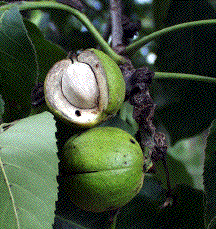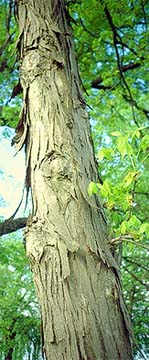Nature Lesson


Somewhere in the Lord of the Rings cycle I seem to remember an episode with marching trees moving to attack. In England, I don’t know what kind of trees those would be, but in New England, they would undoubtedly be shagbark hickories. These trees are smart and they can get very aggressive.
Wikipedia says, “The trees bear too seldom for them to be grown commercially.” That’s because the trees figured out that if they produced every year, the squirrels would multiply to the number needed to eat all the nuts. They are “a preferred food” of squirrels, chipmunks, black bears, gray and red foxes, rabbits, and white-footed mice plus bird species such as mallards, wood ducks, bobwhites, and wild turkey – and knowledgeable human beings. But by taking an occasional year off, the trees control these populations and the next year more nuts will survive to produce the next generation of hickory trees. That’s smart; and the trees figured that out aeons ago. They also developed their own patented shaggy bark that makes it hard for squirrels to climb.
And as for aggressive: I have a grove of shagbark hickories and this time of year I check daily, hoping to get there before the squirrels. Most days I find a dozen or two dozen and go home happy. Last week, one of the trees saw me coming and opened fire. In ten or fifteen minutes at least twenty or thirty nuts came down. I could hear them whistling ominously down through the dry leaves and hitting the ground on all sides of me with dull thuds. Sometimes they came down two or three at a time. One salvo of three came within four feet of me. I finally decided it wasn’t safe there and went on to other things. When I went back later there were one or two more on the ground but the tree, having driven me away, had ceased firing.
Each tree has its own personality. Some send down all their nuts in a few days, others spread delivery out over several weeks. Most send down nuts in a thick green husk that needs to be removed. Some send down nuts and husks separately. I know only one tree that does that consistently and I won’t tell you where it is but it makes my life a lot easier.
So you find the trees, collect the nuts – then what? Wait for the husks to dry and remove them. Then you have a nut about an inch in diameter that has to be attacked with a hammer or heavy duty nut cracker. I have one with an arm eighteen inches long to provide the leverage needed to crack the nut. Then you take the cracked nuts with some small dishes for the nut meats and shells to a comfortable chair and get to work with a standard hand-held nut cracker and pick. Plan for an evening when there’s a good sports event, preferably a football game so you can get your work done between plays. In a couple of hours you might get through a hundred or more nuts. You then put the nut meats in a plastic bag in the freezer and repeat the process day after day. After several days, if you are persistent, you will have enough to make a hickory nut pie. It’s like a pecan pie except much better. You use hickory nuts instead of pecans and maple syrup instead of molasses. The hickory nuts are much smaller than pecans (the trees are actually related to each other) but much sweeter.
And why isn’t hickory nut pie on the menu in the better restaurants? Well, the same technique that kills off the squirrels, kills of the people who might do the work. How many restaurants can provide an item so unreliably available and requiring so much labor? I know, in fact, of only one place in America where this ambrosial item is available – and don’t try to get there without an invitation. My hickory trees are programmed to repel invaders.
 Christopher L. Webber
Christopher L. Webber
I’m grateful to you for enduring the Attack of the Hickory Trees so that we can eat a good pie this Thanksgiving!!